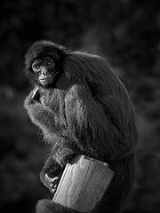
Colombian Spider Monkey
Encyclopedia
The Colombian spider monkey (Ateles fusciceps rufiventris), is a subspecies of the Black-headed spider monkey
, a type of New World monkey
, found in Colombia
and Panama
. Some authorities, such as Froelich (1991), Collins and Dubach (2001) and Nieves (2005), do not recognize the Black-headed spider monkey as a distinct species and so treat the Colombian spider monkey as a subspecies of Geoffroy's spider monkey
.
The Colombian spider monkey lives in dry forests, humid forests and cloud forests, and can live up to 2000 to 2500 m (6,561.7 to 8,202.1 ft) above sea level. It is entirely black with some white on its chin while the Brown-headed spider monkey
(A. f. fusciceps) has a black or brown body and a brown head.
The spider monkey has a black body and long limbs with thumb-less hands. It has a prehensile and extremely flexible tail, which acts as an extra limb. The tail has a hairless patch on the tip that is used for grip. This hairless patch is unique in its markings, just like the human fingerprint. Colombian spider monkeys can weigh up to 9.1 kg (20 pounds). Fruit makes up eighty percent of the spider monkey's diet, which also includes leaves, nuts, seeds, bark, insects, and flowers. Spider monkeys contribute to the dispersion of undigested seeds from the fruits they eat. This monkey lives approximately 24 years.
Spider monkeys are found in social groups of up to 30 individuals; however, they are usually broken up into smaller foraging groups of 3-4 individuals. They move and climb through the forest by hand over hand (brachiation) motion.
Black-headed Spider Monkey
The Black-headed spider monkey, Ateles fusciceps, is a species of spider monkey, a type of New World monkey, from Central and South America. It is found in Colombia, Nicaragua and Panama. Although primatologists such as Colin Groves follow Kellogg and Goldman in treating A...
, a type of New World monkey
New World monkey
New World monkeys are the five families of primates that are found in Central and South America: Callitrichidae, Cebidae, Aotidae, Pitheciidae, and Atelidae. The five families are ranked together as the Platyrrhini parvorder and the Ceboidea superfamily, which are essentially synonymous since...
, found in Colombia
Colombia
Colombia, officially the Republic of Colombia , is a unitary constitutional republic comprising thirty-two departments. The country is located in northwestern South America, bordered to the east by Venezuela and Brazil; to the south by Ecuador and Peru; to the north by the Caribbean Sea; to the...
and Panama
Panama
Panama , officially the Republic of Panama , is the southernmost country of Central America. Situated on the isthmus connecting North and South America, it is bordered by Costa Rica to the northwest, Colombia to the southeast, the Caribbean Sea to the north and the Pacific Ocean to the south. The...
. Some authorities, such as Froelich (1991), Collins and Dubach (2001) and Nieves (2005), do not recognize the Black-headed spider monkey as a distinct species and so treat the Colombian spider monkey as a subspecies of Geoffroy's spider monkey
Geoffroy's Spider Monkey
Geoffroy's spider monkey, Ateles geoffroyi, also known as black-handed spider monkey, is a species of spider monkey, a type of New World monkey, from Central America, parts of Mexico and possibly a small portion of Colombia. There are at least five subspecies. Some primatologists classify the...
.
The Colombian spider monkey lives in dry forests, humid forests and cloud forests, and can live up to 2000 to 2500 m (6,561.7 to 8,202.1 ft) above sea level. It is entirely black with some white on its chin while the Brown-headed spider monkey
Brown-headed Spider Monkey
The Brown-headed spider monkey , is a subspecies of the Black-headed spider monkey, a type of New World monkey, found in Ecuador. Its type locality is at 1500 m in the Hacienda Chinipamba, Imbabura Province in North-West Ecuador...
(A. f. fusciceps) has a black or brown body and a brown head.
The spider monkey has a black body and long limbs with thumb-less hands. It has a prehensile and extremely flexible tail, which acts as an extra limb. The tail has a hairless patch on the tip that is used for grip. This hairless patch is unique in its markings, just like the human fingerprint. Colombian spider monkeys can weigh up to 9.1 kg (20 pounds). Fruit makes up eighty percent of the spider monkey's diet, which also includes leaves, nuts, seeds, bark, insects, and flowers. Spider monkeys contribute to the dispersion of undigested seeds from the fruits they eat. This monkey lives approximately 24 years.
Spider monkeys are found in social groups of up to 30 individuals; however, they are usually broken up into smaller foraging groups of 3-4 individuals. They move and climb through the forest by hand over hand (brachiation) motion.

